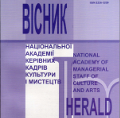Г. ВЕНЯВСЬКИЙ У ПРЕДСТАВНИЦТВІ ПОЛЬСЬКОЇ СКРИПКОВОЇ ШКОЛИ (НА МАТЕРІАЛІ КОНЦЕРТУ № 2)
H. WENIAWSKY AT THE REPRESENTATIVE OFFICE OF POLISH VIOLIN SCHOOL (ON THE MATERIAL OF THE CONCERT NO. 2)
Author(s): Liu BeiSubject(s): Theatre, Dance, Performing Arts, Cultural history, Music, 19th Century, History of Art
Published by: Національна академія керівних кадрів культури і мистецтв
Keywords: violin art; performance style; style in music; musical genre; romanticism; symbolism;
Summary/Abstract: The purpose of the study is to identify the features that distinguish the characteristics of the Polish violin school, which, since the time of K. Lipinski has established itself in an independent stylistic and creative position in the European artistic schedule. The analysis of Violin Concerto No. 2 by G. Wieniawski, which embodied the distinctive features of its author's performing handwriting, clarifies the stylistic face of the outstanding Polish musician. The methodological basis of the work is the intonation approach of the school of B. Asafiev in Ukraine, represented by the works of D. Androsova, O. Hysa, O. Markova, O. Chaika, and other scholars who made a difference in the development of instrumental music, violin, including in the direction of stylistic distinctions of performing schools. The methods of analysis involved are comparative-stylistic, musicological-hermeneutic, biographical-descriptive, cultural interdisciplinary, and others. The scientific novelty of the study is determined by the originality of the idea of the stylistic and performance independence of the Polish violin school based on the proto-symbolism of F. Chopin and the sense of national pathos of K. Lipinski's playing. For the first time in Ukrainian musicology, an analysis of Violin Concerto No. 2 by G. Veniavskyi is presented from the perspective of the stylistic representation of the named author, which embodied in the composition the acquisition of musical proto-symbolism of F. Chopin meaning in the direction of the compositional discoveries of K. Shymanovskyi, performed by E. Mlynarskyi and P. Kohanskyi. Conclusions. In the 19th century, the Polish artistic and musical school was noted for the work of composers and performers in one person, among whom M. Szymanowska, K. Lipinski, and F. Chopin became stars of the first magnitude. The significance of the performance achievements of the virtuoso violinist H. Veniavskyi, who is unconditionally associated with romanticism, is adjusted in this analysis in favour of proto-symbolist content. The "excessive" virtuosity of H. Veniavskyi, embodied in the passage "overload" of the Violin Concerto No. 2, has an obvious consequence in relation to vocal bel canto as the custodian of the church tradition of calophony, which separates from realistic mimesis and elevates a superhuman meaning to symbolism.
Journal: Вісник Національної академії керівних кадрів культури і мистецтв
- Issue Year: 2023
- Issue No: 3
- Page Range: 288-293
- Page Count: 6
- Language: Ukrainian

